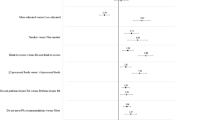Abstract
Background
Television (TV) viewing is a highly prevalent sedentary behavior in young people and has played a significant role in the assessment of sedentary behaviors. An important question to be addressed is to what extent TV viewing is a suitable indicator, or marker, of overall levels of sedentary behavior in children and adolescents. This has not yet been attempted in youth, but has already been attempted in Australian adults.
Purpose
This study was conducted to test whether TV viewing in UK teenagers is a marker of sedentary behavior more broadly and to see if the results mirror those of Australian adults.
Methods
Ecological momentary assessment time-use diaries were completed by 561 boys and 923 girls (mean age 14.67 years) in which weekday and weekend out-of-school time behaviors were recorded every 15 min.
Results
TV viewing was negatively associated with other leisure-time sedentary behaviors for both boys and girls for weekdays and weekends. Higher levels of TV viewing were associated with less time in other key sedentary behaviors, such as computer use in boys and motorized transport in girls.
Conclusions
TV viewing appears not to reflect additional time in other sedentary behaviors in British teenagers, in contrast to data from Australian women. Studies of sedentary behavior should encompass as wide a range of behaviors as possible.

Similar content being viewed by others
Notes
We are grateful to an anonymous reviewer for raising this issue.
References
Pate RR, O’Neill JR, Lobelo F. The evolving definition of ‘sedentary’. Exerc Sport Sci Rev. 2008; 36(4): 173–178.
Smith AL, Biddle SJH. Youth physical activity and sedentary behavior: challenges and solutions. Champaign: Human Kinetics; 2008.
Gorely T, Marshall SJ, Biddle SJH, Cameron N. The prevalence of leisure time sedentary behaviour and physical activity in adolescent girls: an ecological momentary assessment approach. Int J Pediatr Obes. 2007; 2(4): 227–234.
Gorely T, Marshall SJ, Biddle SJH, Cameron N. Patterns of sedentary behaviour and physical activity among adolescents in the United Kingdom: project STIL. J Behav Med. 2007; 30(6): 521–531.
Marshall SJ, Biddle SJH, Sallis JF, McKenzie TL, Conway TL. Clustering of sedentary behaviours and physical activity among youth: a cross-national study. Pediatr Exerc Sci. 2002; 14: 401–417.
Marshall SJ, Gorely T, Biddle SJH. A descriptive epidemiology of screen-based media use in youth: a review and critique. J Adolesc. 2006; 29(3): 333–349.
Olds T, Ridley K, Dollman J. Screenieboppers and extreme screenies: the place of screen time in the time budgets of 10–13 year-old Australian children. Aust N Z J Public Health. 2006; 30(2): 137–142.
Viner RM, Cole TJ. Television viewing in early childhood predicts adult body mass index. J Pediatr. 2005; 147: 429–435.
Marshall SJ, Biddle SJH, Gorely T, Cameron N, Murdey I. Relationships between media use, body fatness and physical activity in children and youth: a meta-analysis. Int J Obes. 2004; 28: 1238–1246.
Sugiyama T, Healy GN, Dunstan DW, Salmon J, Owen N. Is television viewing time a marker of a broader pattern of sedentary behavior? Ann Behav Med. 2008; 35: 245–250.
Department for Education and Skills/Department for Transport. Travelling to school: an action plan. London: DfES; 2003.
Smyth JM, Stone AR. Ecological momentary assessment research in behavioral medicine. J Happiness Stud. 2003; 4: 35–52.
Saudargas RA, Zanolli K. Momentary time sampling as an estimate of percentage time: a field validation. J Appl Behav Anal. 1990; 23: 533–537.
Baranowski T, Jago R. Understanding mechanisms of change in children’s physical activity programs. Exerc Sport Sci Rev. 2005; 33(4): 163–168.
Ommundsen Y, Klasson-Heggebo L, Anderssen S. Psycho-social and environmental correlates of location-specific physical activity among 9- and 15-year-old Norwegian boys and girls: the European Youth Heart Study. Int J Behav Nutr Phys Activ. 2006; 3: 32. http://www.ijbnpa.org/content/3/1/32.
American Academy of Pediatrics. Television and the family. Elk Grove Village III: American Academy of Pediatrics; 1986.
Sallis JF, Prochaska JJ, Taylor WC. A review of correlates of physical activity of children and adolescents. Med Sci Sports Exerc. 2000; 32: 963–975.
Epstein LH, Roemmich JN. Reducing sedentary behaviour: role in modifying physical activity. Exerc Sport Sci Rev. 2001; 29(3): 103–108.
Author information
Authors and Affiliations
Corresponding author
About this article
Cite this article
Biddle, S.J.H., Gorely, T. & Marshall, S.J. Is Television Viewing a Suitable Marker of Sedentary Behavior in Young People?. ann. behav. med. 38, 147–153 (2009). https://doi.org/10.1007/s12160-009-9136-1
Published:
Issue Date:
DOI: https://doi.org/10.1007/s12160-009-9136-1




